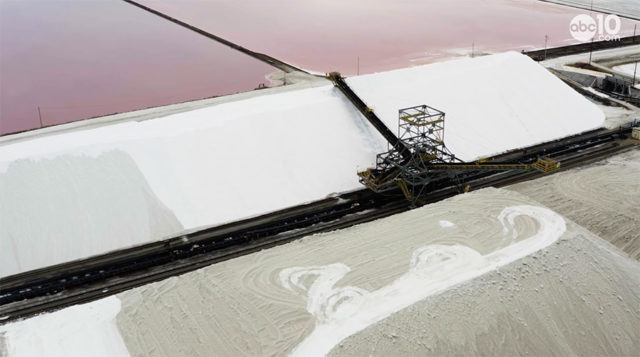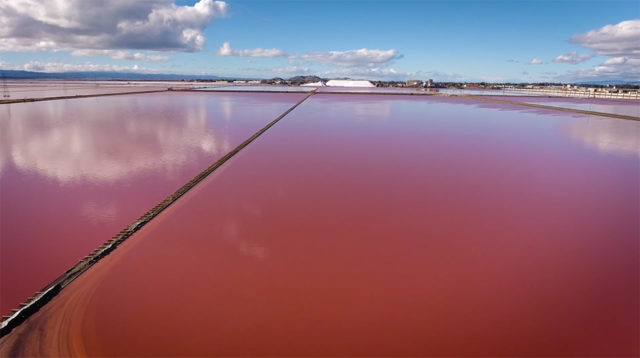Pink, peach, magenta, teal, blue, yellow, and white, Cargill’s San Francisco Bay Salt Ponds are huge colorful brine pools that date back to the California Gold Rush era.
“Using natural power from the sun and wind, Cargill’s 12,000+ acres of salt ponds are capable of crystallizing 500,000 tons of sea salt each year,” a feat made possible by the Bay’s “clay soils and a Mediterranean climate – just enough rain in fall, winter and spring, followed by dry summers with steady breezes and summer sunshine.”
In the video above, a Bartell’s Backroads report from ABC10, John Bartell visits Newark‘s salt ponds to learn more about how Cargill grows salt, as well as how brine shrimp and other colorful microorganisms paint the pools. Some history from Wikipedia:
Salt production goes back to when the Ohlone were the only people in the area. After the large influx of people to the area in the 1850s, industrial production began. At first, production was predominantly small family operations, but over time these were replaced by companies like the Oliver Salt Company in Mount Eden and Leslie Salt in Newark. Eventually, Cargill bought out the companies to become the dominant producer in the area. Since 2003, there has been a move to close the ponds and return the area to its natural state. This process may take as long as thirty years.
More about salt pond restoration from The South Bay Salt Pond Restoration Project:
San Francisco Bay has lost an estimated 85 percent of its historic wetlands to fill or alteration. This dramatic decline in tidal marsh habitats has caused populations of marsh-dependent fish and wildlife to dwindle. It has also decreased water quality and increased local flood risks. Restoration of the South Bay salt ponds provides an opportunity to begin to reverse these trends, by improving the health of San Francisco Bay for years to come.
Fly over the remaining ~12,000 acres of Cargill’s salt ponds with this six-minute drone video:
Related reading at Hakai: Rebirth of San Francisco’s Salt Marshes.
Watch these handpicked related videos next:
• Salt and Pepper, an Edible Histories introduction
• An Alpine ibex defies gravity to lick salt
• Motoi Yamamoto’s intricate, temporary salt installations
• Why is Lake Hillier pink?
• Yellowstone’s Grand Prismatic Spring
• Reflections from Uyuni: Water across the world’s largest salt flat
Curated, kid-friendly, independently-published. Support this mission by becoming a sustaining member today.




